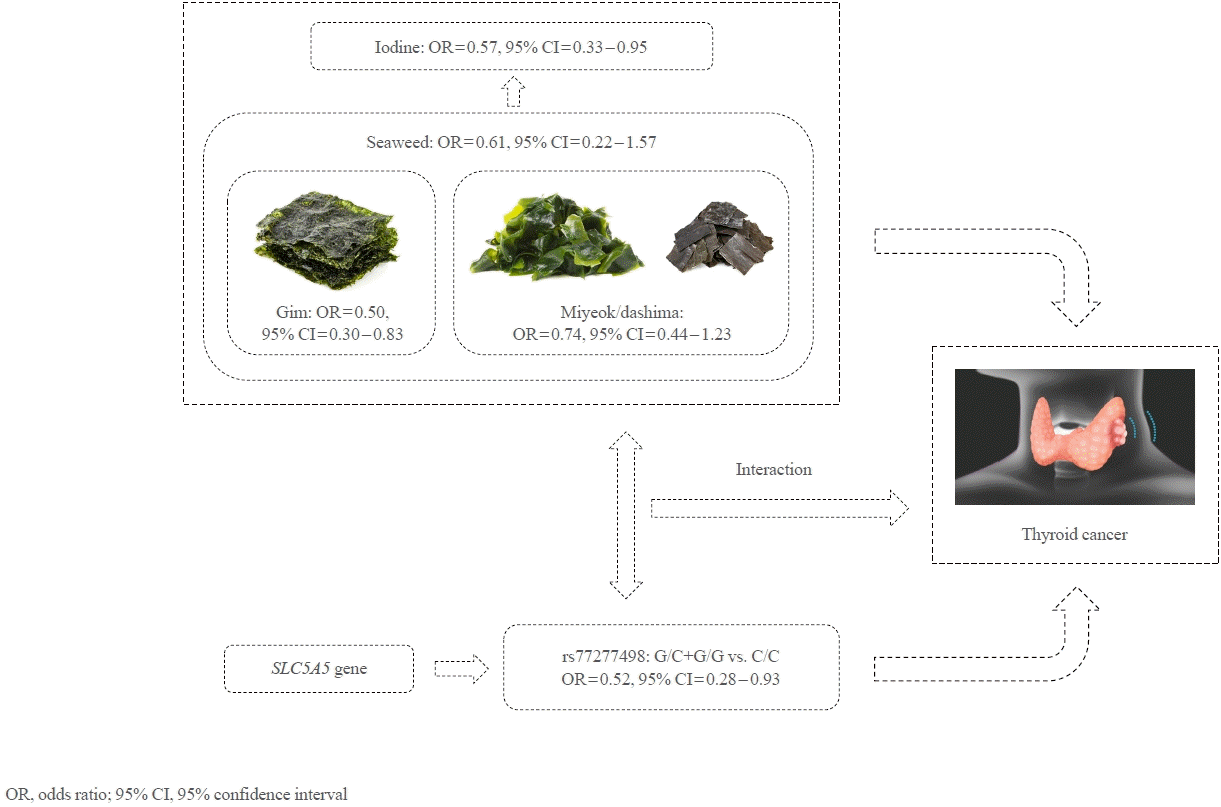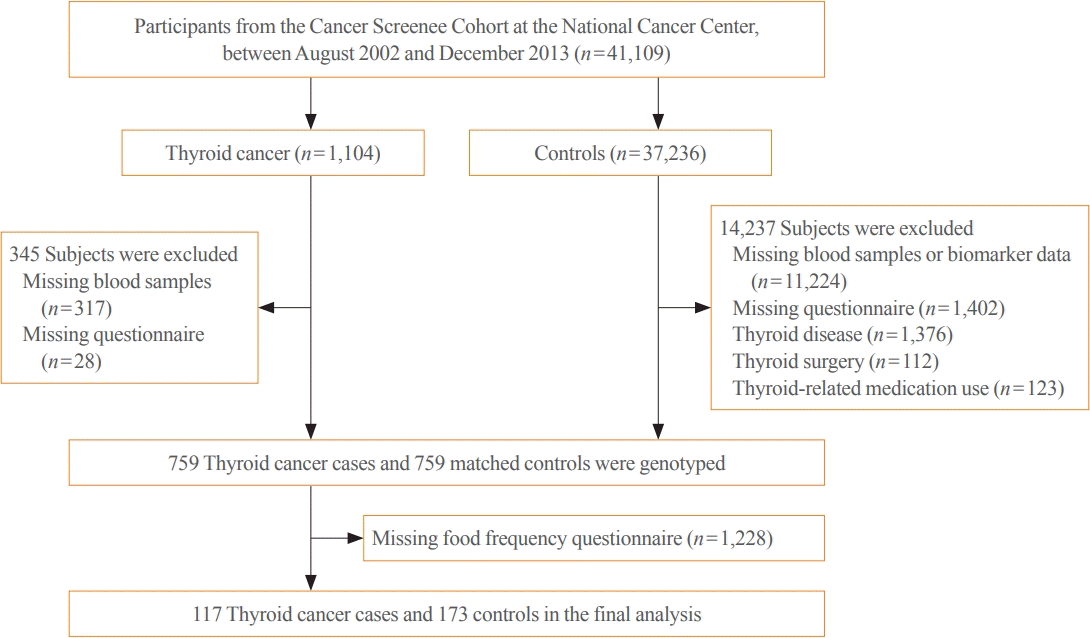1. Sung H, Ferlay J, Siegel RL, Laversanne M, Soerjomataram I, Jemal A, et al. Global cancer statistics 2020: GLOBOCAN estimates of incidence and mortality worldwide for 36 cancers in 185 countries. CA Cancer J Clin. 2021; 71:209–49.

2. Jung KW, Won YJ, Hong S, Kong HJ, Im JS, Seo HG. Prediction of cancer incidence and mortality in Korea, 2021. Cancer Res Treat. 2021; 53:316–22.

3. Iglesias ML, Schmidt A, Ghuzlan AA, Lacroix L, Vathaire F, Chevillard S, et al. Radiation exposure and thyroid cancer: a review. Arch Endocrinol Metab. 2017; 61:180–7.

4. Kitahara CM, McCullough ML, Franceschi S, Rinaldi S, Wolk A, Neta G, et al. Anthropometric factors and thyroid cancer risk by histological subtype: pooled analysis of 22 prospective studies. Thyroid. 2016; 26:306–18.

5. Aakre I, Tveito Evensen L, Kjellevold M, Dahl L, Henjum S, Alexander J, et al. Iodine status and thyroid function in a group of seaweed consumers in Norway. Nutrients. 2020; 12:3483.

6. Ju DL, Park YJ, Paik HY, Kim MJ, Park S, Jung KY, et al. Dietary evaluation of a low-iodine diet in Korean thyroid cancer patients preparing for radioactive iodine therapy in an iodine-rich region. Nutr Res Pract. 2016; 10:167–74.

7. Han MR, Ju DL, Park YJ, Paik HY, Song Y. An iodine database for common Korean foods and the association between iodine intake and thyroid disease in Korean adults. Int J Thyroidol. 2015; 8:170–82.

8. Park JK, Woo HW, Kim MK, Shin J, Lee YH, Shin DH, et al. Dietary iodine, seaweed consumption, and incidence risk of metabolic syndrome among postmenopausal women: a prospective analysis of the Korean Multi-Rural Communities Cohort Study (MRCohort). Eur J Nutr. 2021; 60:135–46.

9. Kim J, Lee J, Oh JH, Chang HJ, Sohn DK, Shin A, et al. Associations among dietary seaweed intake, c-MYC rs698-3267 polymorphism, and risk of colorectal cancer in a Korean population: a case-control study. Eur J Nutr. 2020; 59:1963–74.

10. Ganesa AR, Tiwari U, Rajauria G. Seaweed nutraceuticals and their therapeutic role in disease prevention. Food Sci Hum Wellness. 2019; 8:252–63.

11. Ruan BF, Ge WW, Lin MX, Li QS. A review of the components of seaweeds as potential candidates in cancer therapy. Anticancer Agents Med Chem. 2018; 18:354–66.

12. Gutierrez-Rodriguez AG, Juarez-Portilla C, Olivares-Banuelos T, Zepeda RC. Anticancer activity of seaweeds. Drug Discov Today. 2018; 23:434–47.

13. de Morais RM, Sobrinho AB, de Souza Silva CM, de Oliveira JR, da Silva I, de Toledo Nobrega O. The role of the NIS (SLC5A5) gene in papillary thyroid cancer: a systematic review. Int J Endocrinol. 2018; 2018:9128754.

14. Tavares C, Coelho MJ, Eloy C, Melo M, da Rocha AG, Pestana A, et al. NIS expression in thyroid tumors, relation with prognosis clinicopathological and molecular features. Endocr Connect. 2018; 7:78–90.

15. Darrouzet E, Lindenthal S, Marcellin D, Pellequer JL, Pourcher T. The sodium/iodide symporter: state of the art of its molecular characterization. Biochim Biophys Acta. 2014; 1838(1 Pt B):244–53.

16. Kogai T, Taki K, Brent GA. Enhancement of sodium/iodide symporter expression in thyroid and breast cancer. Endocr Relat Cancer. 2006; 13:797–826.

17. Kim J. Cancer screenee cohort study of the National Cancer Center in South Korea. Epidemiol Health. 2014; 36:e2014013.

18. Hoang T, Nguyen Ngoc Q, Lee J, Lee EK, Hwangbo Y, Kim J. Evaluation of modifiable factors and polygenic risk score in thyroid cancer. Endocr Relat Cancer. 2021; 28:481–94.

19. Ahn Y, Kwon E, Shim JE, Park MK, Joo Y, Kimm K, et al. Validation and reproducibility of food frequency questionnaire for Korean genome epidemiologic study. Eur J Clin Nutr. 2007; 61:1435–41.

20. Tomova GD, Arnold KF, Gilthorpe MS, Tennant P. Adjustment for energy intake in nutritional research: a causal inference perspective. Am J Clin Nutr. 2022; 115:189–98.

21. Brown CC, Kipnis V, Freedman LS, Hartman AM, Schatzkin A, Wacholder S. Energy adjustment methods for nutritional epidemiology: the effect of categorization. Am J Epidemiol. 1994; 139:323–38.

22. Delaneau O, Howie B, Cox AJ, Zagury JF, Marchini J. Haplotype estimation using sequencing reads. Am J Hum Genet. 2013; 93:687–96.

23. Howie BN, Donnelly P, Marchini J. A flexible and accurate genotype imputation method for the next generation of genome-wide association studies. PLoS Genet. 2009; 5:e1000529.

23. Cho TJ, Rhee MS. Health functionality and quality control of laver (Porphyra, Pyropia): current issues and future perspectives as an edible seaweed. Mar Drugs. 2019; 18:14.

25. Etman SM, Abdallah OY, Elnaggar YSR. Novel fucoidan based bioactive targeted nanoparticles from Undaria pinnatifida for treatment of pancreatic cancer. Int J Biol Macromol. 2020; 145:390–401.

26. Hsu HY, Hwang PA. Clinical applications of fucoidan in translational medicine for adjuvant cancer therapy. Clin Transl Med. 2019; 8:15.

27. Burney M, Mathew L, Gaikwad A, Nugent EK, Gonzalez AO, Smith JA. Evaluation fucoidan extracts from Undaria pinnatifida and Fucus vesiculosus in combination with anticancer drugs in human cancer orthotopic mouse models. Integr Cancer Ther. 2018; 17:755–61.

28. Han YS, Lee JH, Lee SH. Fucoidan inhibits the migration and proliferation of HT-29 human colon cancer cells via the phosphoinositide-3 kinase/Akt/mechanistic target of rapamycin pathways. Mol Med Rep. 2015; 12:3446–52.

29. Mak W, Wang SK, Liu T, Hamid N, Li Y, Lu J, et al. Anti-proliferation potential and content of fucoidan extracted from sporophyll of New Zealand Undaria pinnatifida. Front Nutr. 2014; 1:9.

30. Yang L, Wang P, Wang H, Li Q, Teng H, Liu Z, et al. Fucoidan derived from Undaria pinnatifida induces apoptosis in human hepatocellular carcinoma SMMC-7721 cells via the ROS-mediated mitochondrial pathway. Mar Drugs. 2013; 11:1961–76.

31. Tian L, Li CM, Li YF, Huang TM, Chao NX, Luo GR, et al. Laminarin from seaweed (Laminaria japonica) inhibits hepatocellular carcinoma through upregulating senescence marker protein-30. Cancer Biother Radiopharm. 2020; 35:277–83.
32. Mei C, Zhou S, Zhu L, Ming J, Zeng F, Xu R. Antitumor effects of Laminaria extract fucoxanthin on lung cancer. Mar Drugs. 2017; 15:39.

33. Go H, Hwang HJ, Nam TJ. A glycoprotein from Laminaria japonica induces apoptosis in HT-29 colon cancer cells. Toxicol In Vitro. 2010; 24:1546–53.

34. Yang H, Zeng M, Dong S, Liu Z, Li R. Anti-proliferative activity of phlorotannin extracts from brown algae Laminaria japonica Aresch. Chin J Oceanol Limnol. 2010; 28:122–30.

35. Yao M, Qian X, Qin H. Effects of Laminaria japonica polysaccharides on the survival of non-small-cell lung cancer A549 cells. Int J Polym Sci. 2019; 2019:1–9.

36. Zimmermann MB, Galetti V. Iodine intake as a risk factor for thyroid cancer: a comprehensive review of animal and human studies. Thyroid Res. 2015; 8:8.

37. Cao LZ, Peng XD, Xie JP, Yang FH, Wen HL, Li S. The relationship between iodine intake and the risk of thyroid cancer: a meta-analysis. Medicine (Baltimore). 2017; 96:e6734.
38. Farebrother J, Zimmermann MB, Andersson M. Excess iodine intake: sources, assessment, and effects on thyroid function. Ann N Y Acad Sci. 2019; 1446:44–65.

39. Katagiri R, Yuan X, Kobayashi S, Sasaki S. Effect of excess iodine intake on thyroid diseases in different populations: a systematic review and meta-analyses including observational studies. PLoS One. 2017; 12:e0173722.

40. Leung AM, Braverman LE. Consequences of excess iodine. Nat Rev Endocrinol. 2014; 10:136–42.

41. Kim K, Cho SW, Park YJ, Lee KE, Lee DW, Park SK. Association between iodine intake, thyroid function, and papillary thyroid cancer: a case-control study. Endocrinol Metab (Seoul). 2021; 36:790–9.

42. Rosignolo F, Maggisano V, Sponziello M, Celano M, Di Gioia CR, D’Agostino M, et al. Reduced expression of THRβ in papillary thyroid carcinomas: relationship with BRAF mutation, aggressiveness and miR expression. J Endocrinol Invest. 2015; 38:1283–9.

43. Lee SJ, Choi KC, Han JP, Park YE, Choi MG. Relationship of sodium/iodide symporter expression with I131 whole body scan uptake between primary and metastatic lymph node papillary thyroid carcinomas. J Endocrinol Invest. 2007; 30:28–34.

44. Zafon C, Gil J, Perez-Gonzalez B, Jorda M. DNA methylation in thyroid cancer. Endocr Relat Cancer. 2019; 26:R415–39.

45. Russo D, Manole D, Arturi F, Suarez HG, Schlumberger M, Filetti S, et al. Absence of sodium/iodide symporter gene mutations in differentiated human thyroid carcinomas. Thyroid. 2001; 11:37–9.

46. Kim JH, Lee J, Choi IJ, Kim YI, Kim J. Dietary patterns and gastric cancer risk in a Korean population: a case-control study. Eur J Nutr. 2021; 60:389–97.

47. Gunathilake M, Lee J, Choi IJ, Kim YI, Kim J. identification of dietary pattern networks associated with gastric cancer using gaussian graphical models: a case-control study. Cancers (Basel). 2020; 12:1044.

48. Kim JH, Lee J, Choi IJ, Kim YI, Kwon O, Kim H, et al. Dietary carotenoids intake and the risk of gastric cancer: a case-control study in Korea. Nutrients. 2018; 10:1031.

49. Poslusna K, Ruprich J, de Vries JH, Jakubikova M, van’t Veer P. Misreporting of energy and micronutrient intake estimated by food records and 24 hour recalls, control and adjustment methods in practice. Br J Nutr. 2009; 101 Suppl 2:S73–85.
50. Hoang T, Lee J, Kim J. Differences in dietary patterns identified by the gaussian graphical model in Korean adults with and without a self-reported cancer diagnosis. J Acad Nutr Diet. 2021; 121:1484–96.

51. Hoang T, Lee J, Kim J, Park B. Food intake behavior in cancer survivors in comparison with healthy general population; from the health examination center-based cohort. J Cancer Prev. 2019; 24:208–16.

52. Jung YS, Oh CM, Kim Y, Jung KW, Ryu J, Won YJ. Longterm survival of patients with thyroid cancer according to the methods of tumor detection: a nationwide cohort study in Korea. PLoS One. 2018; 13:e0194743.

53. Ahn HS, Kim HJ, Kim KH, Lee YS, Han SJ, Kim Y, et al. Thyroid cancer screening in South Korea increases detection of papillary cancers with no impact on other subtypes or thyroid cancer mortality. Thyroid. 2016; 26:1535–40.

54. Hoang T, Song D, Lee J, Lee EK, Hwangbo Y, Kim J. Association among body mass index, genetic variants of FTO, and thyroid cancer risk: a hospital-based case-control study of the Cancer Screenee Cohort in Korea. Cancer Res Treat. 2021; 53:857–73.

55. Myung SK, Lee CW, Lee J, Kim J, Kim HS. Risk factors for thyroid cancer: a hospital-based case-control study in Korean adults. Cancer Res Treat. 2017; 49:70–8.

56. Oh CM, Jung KW, Won YJ, Shin A, Kong HJ, Lee JS. Age-period-cohort analysis of thyroid cancer incidence in Korea. Cancer Res Treat. 2015; 47:362–9.

57. Cherry P, O’Hara C, Magee PJ, McSorley EM, Allsopp PJ. Risks and benefits of consuming edible seaweeds. Nutr Rev. 2019; 77:307–29.

58. Penalver R, Lorenzo JM, Ros G, Amarowicz R, Pateiro M, Nieto G. Seaweeds as a functional ingredient for a healthy diet. Mar Drugs. 2020; 18:301.





 PDF
PDF Citation
Citation Print
Print





 XML Download
XML Download